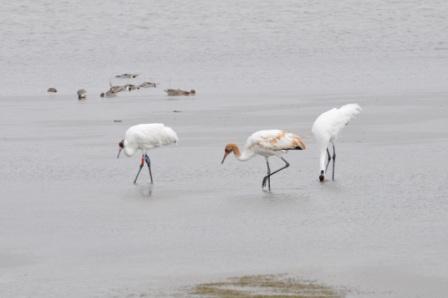Most of the estimated 300 whooping cranes of the Aransas-Wood Buffalo population have now arrived on the Aransas National Wildlife Refuge on the Texas coast. The whoopers began arriving on the Texas coastal bend and Aransas National Wildlife Refuge wintering grounds in late October according to Dan Alonso, Refuge Manager. Regrettably the refuge habitat is suffering from the long drought that affects most of the state of Texas. “Habitat conditions appear to be somewhat challenging for whooping cranes this year, specifically with regard to drought and salinity aspects” advises refuge manager Alonso.
Salinity levels in the San Antonia Bay are currently 35.3 parts per thousand, resulting in many cranes frequently using inland freshwater sources according to refuge officials. “To date, Aransas National Wildlife Refuge has received 14 inches of precipitation, which is approximately 23 inches below the annual average” according to Alonso. In addition, harmful algae blooms, known as red tide, have occurred along the Texas coast. Red tide toxins can accumulate in fish, oysters and clams in the bays, possibly causing illness and/or death to cranes and other wildlife consuming toxic seafood. “Fortunately, there are no known reports of cranes dying from the red tide in past outbreaks but biologists continue to keep a
vigilant watch. Fortunately cooler temperatures have helped reduce red tide blooms”, refuge officials say.
Aransas biologists made their initial plane flight of the season on December 8 to check out the first whooping crane mortality discovered on Aransas according to a refuge report. One juvenile crane was found dead from unknown causes. The carcass has been sent to the National Wildlife Health Center in Madison, WI for disease testing.
Aransas officials say the goal of the first flight was also to assess the general distribution and condition of the whooping crane population. During the flight, biologists observed a significant number of cranes in the uplands, as opposed to marshlands where they are typically found. Field observations have resulted in biologists finding evidence of wolfberry and blue crab remains in crane scat. It appears that cranes are utilizing some resources within the marsh. A second flight to estimate the crane population will be scheduled for January 2011 according to refuge personnel.
Recognizing the potential problems associated with the extreme drought conditions along the entire Texas coast, Aransas officials spent the summer months planning for the return of the whoopers. This included initiating work to maximize freshwater output from existing wells located throughout the refuge. And the refuge has had some valuable assistance from the private sector.
The Friends of Aransas and Matagorda Island National Wildlife Refuge, a non-profit organization of volunteers are dedicated to supporting the refuge in its goal of enhancing habitat and wildlife. They have been instrumental in raising funds for converting windmills to solar pump energy. This conversion is intended to provide a more reliable fresh water supply for wildlife. Refuge personnel are also planning to prescribe burn over 9,700 acres to provide additional food resources for cranes. The refuge recently conducted its first burn of the season, consisting of 654 acres of whooping crane habitat. Refuge officials reported that the cranes made immediate use of the prescribe burned areas.
The Whooping Crane Conservation Association believes that Aransas officials are doing everything within their capabilities to compensate for the “challenging” habitat conditions on the refuge. Mother Nature has dealt Aransas Refuge and most of the state of Texas a serious blow with the long term drought. After a successful nesting season, with approximately 37 chicks fledging from a record of 75 nests in August 2011, biologists anticipate that the flock size could reach record levels this winter, possibly 300. The large whooper population will now face degraded habitat conditions and hopefully they will overcome the taxing situation.


